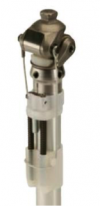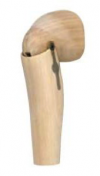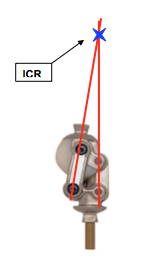Prosthetic knees can be divided into Mechanical or Computerized. Mechanical knees can then be subdivided into single-axis and multiaxis/polycentric knees. All prosthetic knee require some sort of stability mechanism, this can be manual or a weight-activated locking system. They also require a way to control the flexion and extension motion, this can be done by friction or a hydraulic/pneumatic control. Different prosthetic knee technology will be mentioned below, manufacturers use a combination of these technologies together to create different types of prosthetic knees. There are many varieties of prosthetic knee on the market and this page only covers the concepts and not specific brands. When assessing a patient for the first time or when they upgrade their prosthesis it is important to go to ask the prosthesist and or do a web search to read more about the knee/prosthesis and watch the available videos. Each knee has different features that will influence the gait of the individual as well as the rehabilitation with regards to sitting down or standing up, ramps, stairs, uneven terrain and walking and different speeds.
Mechanical Knees [1][2]
Single-Axis Knees
- Mechanism: This is a simple hinge type knee.
During the flexion/extension these articulations execute a simple rotation around the knee axis. They are of simple design and their easy alignment responds to the rules of mechanics. There are exoskeletal and endoskeletal knees, both versions can have manual or automatic blocking of the flexion to be used in users with poor muscle power. The knees without blocking can be used for regular prosthetic fitting of amputees with adequate muscle control and/or in situations of limited economic resources.
- Advantages: Very simplistic, durable, very light, and economical.
- Disadvantages: Due to the simplicity the individual has to use their own muscle power in the limb to keep the knee stable with heel contact and standing.
- Additional components: A manual lock can be added to give more stability in standing. A constant friction control can also be added which will prevent the leg from swinging through very quickly.
Polycentric Knees
- Mechanism: This knee has multiple axes of ration and is also called a “four bar” knee. Based on principle of two or more axes of articulation. Knees of the most frequent use are of 4 axes (or 4 bars). Without giving importance to the number of axes, the knees of poly-axial design have one thing in common – the Instant Centre of Rotation (ICR) is situated much higher and posterior than the mechanical axes when the knee is in extension.
To localize the ICR of a polycentric knee, we need to extend virtually the center lines of the lateral bars towards proximal – the intersection of those lines will indicate the ICR. This causes a high level of stability in the knee against involuntary flexion during the heel strike.
- Advantages: It is very versatile in terms of stability and get be adjusted to be extremely stable when the patient goes into stance phase, but in the same time allow and easy swing and allows sitting down with a bent knee. Due to the multiple axes and the ICR the prosthetic length “shortens” at the start of toe off and will allow for foot clearance. It is suitable for patients with the potential to be independent with the prosthesis in their home and community as well as the more active person.
- Disadvantages: It is heavier than single axis knees. More parts that needs servicing. It has a single walking speed but when a manufacturer include pneumatic or hydraulic features the patient will be able to vary their walking speed.
Manual Locking Knee
- Advantages: This will allows for automatic locking of the knee with weight bearing, but the patient can choose to manually unlock the knee. This is especially for people who need extra security to keep the knee from buckling in standing or with heel contact or when walking on uneven terrain. The patient can choose to walk with a locked or unlocked knee.
- Disadvantages: When walking with an unlocked knee it requires the patient to use their muscles to control the knee in standing and to prevent it from buckling. The patient will also need circumduct or hip hitch to allow for foot clearance.
Weight-Activated Stance Control
These knees are also called “safety knees”
- Mechanism: There is a constant friction system in the knee, which means it will apply a braking force as the patient puts weight on the prosthesis, to prevent the knee from buckling. The rest of the time the knee will swing freely, until weight is applied to it.
- Advantages: Very stable knee. Prescribed for first time prosthetic users who need the stability especially in the older or less active population but are still able to exert some control over the knee. Or a person who fatigues quickly after just a few steps. This is especially valuable for the patient who forgets that they should not put their weight on a partially bent knee, the friction in the knee will brake if this happens and prevent the knee from collapsing into flexion.
- Disadvantages: When sitting down the patient will have to take the weight off the leg to allow it to bend, this means that they will not be able to use the prosthetic side in the sitting motion. The patient will also need to take weight off the leg before the knee will bend, this means that the normal knee flexion at toe off will not happen. Due to the friction in the knee the patient will also walk slower and take smaller steps.
Pneumatic or Hydraulic Knees
- Mechanism: This is when a pneumatic or hydraulic component (piston within cylinders containing air or fluid) is added to single-axis or poly-axial knee. These components control the swinging action of the prosthetic knee and allows the individual to vary speeds. When speed is increased the valve in the cylinder closes and gradually limits the air flow/ fluid to limit flexion of the knee, when knee flexion is reduced the individual can walk at a faster pace. The opposite will happen with slower walking, the fluid or air will be able to more easier, allowing for more knee flexion and slower gait. Pneumatic control will compress the air as the knee is flexed and then stores the energy and releases it with knee extension. Spring coils can be added for more control during gait. Pneumatics or hydraulics are also added to computerized prosthetic knees. Hydraulics are better for very active individuals.
- Advantages: The individual will be able to walk more comfortably at different walking speeds with a more natural gait. Less expensive and lighter than computerized knees. Weight can be kept on the prosthetic leg when sitting down and the knee will assist the individual to sit down. The resistance in the knee will allow the individual to climb down step over step when walking down stairs, when weight is kept on the leg before and during the motion.
- Disadvantages: Hydraulic knees are heavier, need more maintenance, and have a higher initial cost when compared to pneumatics. Overall cost is more than earlier mentioned knees.
Microprocessor Knees
- Mechanism: These knees have a micro-processor that receives feedback from sensors located inside the knee joint and/ or the foot. The date from the sensors are used to adjust the knee flexion and extension range and speed to match what the individual requires at that moment in time. It can be explained as an “enhanced hydraulic system” where the computer is controlling the opening and closing of the valves to allow the flow of hydraulic fluid within the unit.
- Advantages: It lowers the amount and effort that an individual needs for walking. More natural gait. The knee is able to quickly adapt to accommodate different walking speeds, changing environment, or for specific situations. Some knees also have stumble recovery to prevent the individual from falling. Can use a mobile device of computer to adjust settings. Can have different walking/ activity modes. Once learned, it takes less cognitive effort. Allows descending stairs step over step. The individual will be able to use the prosthetic side when sitting down or standing up. Some knees offer stumble recovery.
- Disadvantages: Cost – very expensive. Battery needs to charge. Weight is more than other knees. Cosmesis may be difficult. Specific foot selection. Can be damaged by environmental conditions (water, heat, cold, etc), kneeling etc. Initial steep learning curve and commitment to gait re-education. Regular servicing.
Motor Powered Knees
Powered extension for standing up from sitting and controlled resistance when sitting down. Active flexion and extension during gait. Symmetrical weight distribution. Natural gait.
References
United States-India S&T Endowment Fund. Affordable and User-Centric Knee Joints to Remobilize Above-Knee Amputees. Available from: ↑ Ottobock. Prosedo – Locking knee with sitting assist Walking Across Various Terrain. Available from: ↑ Luiz Augusto martins Peixoto. Protese Otto Bock 3R15 / 3R49. Available from: ↑ Deise Nishimura. 3R92 Otto Bock knee. Available from: ↑ Ottobock UK. Ottobock’s 3R80 Waterproof prosthetic knee. Available from: ↑ DelBiancoPO. Patient Education: Mauch Knee. Available from: ↑ NZALS Peke Waihanga, Aotearoa. Knee Joints. ↑ A Step Ahead Prosthetics. Genium Knee: The Technology and Features. Available from: ↑ Ottobock North America. C-Leg 3: How it works. Available from: ↑ The London Prosthetic Centre. Rheo XC – Microprocessor Knees. Available from:




